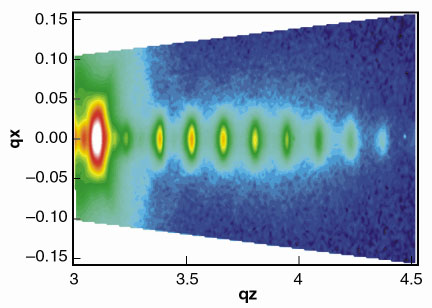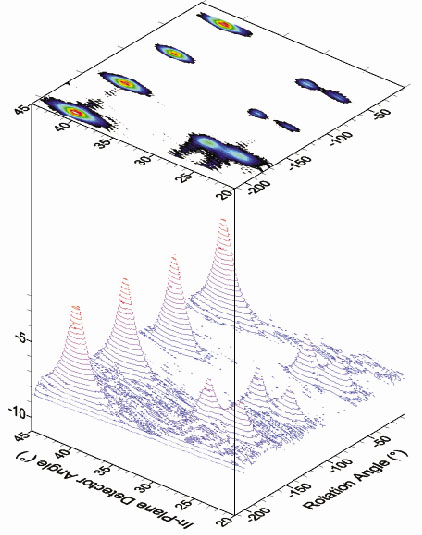- Home
- Users & Science
- Scientific Documentation
- ESRF Highlights
- ESRF Highlights 2001
- Surfaces, Interfaces and Nano-science
- The Electron Waveguide in FeAu Multilayers
The Electron Waveguide in FeAu Multilayers
The electron waveguide effect, often called electron channelling, was predicted by band structure and conductivity calculations. It has been suggested that this effect plays a role in giant magnetoresistance. The channelling occurs because the band structure of Fe is spin dependent and although there is a good band match between the majority bands (the spins that are parallel to the magnetisation) and the Au bands, there is a substantial mismatch between the minority Fe and the Au bands. The upshot is that the minority spin electrons can be confined to the Au layers by specular reflections at the Au/Fe interface. Recent magneto-transport measurements performed at the University of Leeds have only now provided the first experimental evidence of the presence of this phenomenon in magnetic multilayers.
Measurements were performed on Fe/Au multilayers grown by molecular beam epitaxy on either (001) oriented MgO or (110) oriented sapphire. The Fe/Au multilayers grew with (001) and (111) orientation respectively on the two substrates. It was found that the conductivity in a saturating magnetic field was substantially higher for the (001) multilayers than for the (111) multilayers of equal thickness of Au and Fe. Further, the gradient of the conductivity versus Au thickness, at constant Fe thickness, was higher for the (001) multilayers than for the (111) multilayers. Synchrotron radiation experiments undertaken at BM28 played a crucial role in establishing that the result was not an artefact of differing crystal perfection.
Grazing-incidence specular and diffuse scattering established that the multilayers grown on MgO had a roughness amplitude about three times that of those grown on sapphire and that the in-plane correlation length of the roughness was very similar. The higher conductivity of the (001) orientation multilayers therefore did not arise from lower scattering at smoother interfaces. High-resolution diffraction measurements showed comparable lattice perfection in a direction normal to the surface, with both systems exhibiting many superlattice satellites around the 002 and 111 reciprocal lattice points respectively. From reciprocal space maps such as those illustrated in Figure 68, the mosaic distribution has been determined and, for the first time, the variation of the peak width transverse to the diffraction vector has been measured as a function of satellite order. As the mosaic spread of the (111) multilayers is less than that of the (001) multilayers, this removes a further artefact from the interpretation.
 |
Fig. 68: Reciprocal space map around the 002 reciprocal lattice point for a Fe/Au multilayer grown on (001) MgO. |
The in-plane mosaic structure has been measured using grazing-incidence surface diffraction from Bragg planes perpendicular to the surface. From the peak width in a scan in which the sample only is rotated about its surface normal, equivalent to a horizontal cut through the full in-plane reciprocal space map shown in Figure 69, a direct measure of the mosaic spread can be obtained. Once again, the X-ray scattering measurements provided the crucial evidence to demonstrate that the magneto-transport effects were associated with the electron channelling, rather than the different layer or interface structure.
 |
Fig. 69: In-plane reciprocal space map of a Fe/Au (111) multilayer grown on sapphire. The peaks at a detector angle of ~ 45° are the Au (220) peaks. Those near detector angles of 30° show the coexistence of two Fe phases for 20 Å Fe layers. |
By studying in-plane reciprocal space maps such as Figure 69 as a function of Fe thickness, it has additionally been possible to determine the mechanism of the fcc. to bcc. transition that occurs for Fe growth on (111) Au.
Principal Publication and Authors
D.T. Dekadjevi (a), P.A. Ryan (a), B.J. Hickey (a), T.P.A. Hase (b), B.D. Fulthorpe (b) and B.K. Tanner (b), Phys. Rev. Lett., 86, 5787-5790 (2001).
(a) Dept. of Physics, University of Leeds (UK)
(b) Dept.of Physics, University of Durham (UK)



